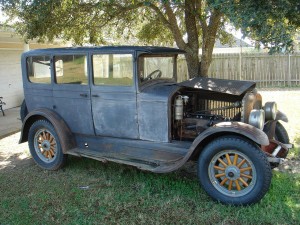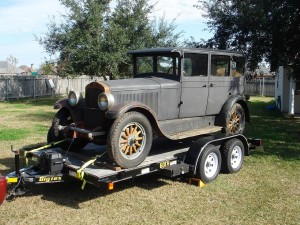The Jordan Motor Car Company was founded in 1916 in Cleveland, Ohio by Edward S. “Ned” Jordan, a former advertising executive from Thomas B. Jeffery Company of Kenosha, Wisconsin. The factory produced what were known as “assembled cars” until 1931, using components from other suppliers. Jordan cars were noted for  attractive styling rather than advanced engineering, although they did bring their share of innovations to the marketplace. The company’s advertising was more original than the cars themselves. Said Jordan, “Cars are too dull and drab.”
attractive styling rather than advanced engineering, although they did bring their share of innovations to the marketplace. The company’s advertising was more original than the cars themselves. Said Jordan, “Cars are too dull and drab.”
Jordan Motor Car established its plant east of downtown Cleveland at 1070 East 152nd Street along the Nickel Plate Railroad tracks. The location not only provided an excellent location for shipping the finished cars, but also provided Jordan with ready access to out of area suppliers. The plant was built in two stages; the first 30,000-square-foot building was begun on April 5, 1916 and finished some seven weeks later, while the second addition was completed within months of the first structure. In their first year of production (1916), Jordan sold over one thousand vehicles.
Jordan cars were powered by Continental engines, used Timken axles, Bijur starters, and Bosch ignitions. According to Ned Jordan’s biographer, James Lackey, the source of early Jordan bodies was somewhat a mystery. While Jordan had the capacity to paint automobile bodies and assemble them to the chassis, the facility was unable to fabricate the bodies themselves. Later production bodies were shipped from a variety of manufacturers in Ohio and Massachusetts. They were fabricated from aluminum with wooden frames.
 While most automobile manufactures limited themselves to a single color combinations, and Ford relied exclusively on the fast-drying Japan Black lacquer which cured in a matter of hours, Jordan automobiles were available in no less than three colors of red – “Apache Red”, “Mercedes Red”, and “Savage Red”- as well as “Ocean Sand Gray”, “Venetian Green”, “Briarcliff Green”, “Egyptian Bronze”, “Liberty Blue” and “Chinese Blue”. All black was also available. The most flamboyant of color schemes was on the four-passenger Sport model which could be ordered in “Submarine Gray”, with khaki top and orange wheels.
While most automobile manufactures limited themselves to a single color combinations, and Ford relied exclusively on the fast-drying Japan Black lacquer which cured in a matter of hours, Jordan automobiles were available in no less than three colors of red – “Apache Red”, “Mercedes Red”, and “Savage Red”- as well as “Ocean Sand Gray”, “Venetian Green”, “Briarcliff Green”, “Egyptian Bronze”, “Liberty Blue” and “Chinese Blue”. All black was also available. The most flamboyant of color schemes was on the four-passenger Sport model which could be ordered in “Submarine Gray”, with khaki top and orange wheels.
Details given the cars were unusually advanced for an independently made assembled car. For example, Jordans boasted one of the first cowl fresh air ventilation systems. Jordan also went to all-steel construction in the mid-1920s, some ten years before Buick, and eight years before Chrysler introduced the advanced Airflow models.
Check out the Jordan Motor Car club at http://clubs.hemmings.com/jordanmotorcar/




